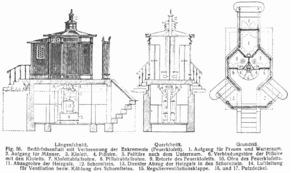
Incinerating toilet
Encyclopedia

Toilet
A toilet is a sanitation fixture used primarily for the disposal of human excrement, often found in a small room referred to as a toilet/bathroom/lavatory...
that burns
Incineration
Incineration is a waste treatment process that involves the combustion of organic substances contained in waste materials. Incineration and other high temperature waste treatment systems are described as "thermal treatment". Incineration of waste materials converts the waste into ash, flue gas, and...
excrement
Human feces
Human feces , also known as a stool, is the waste product of the human digestive system including bacteria. It varies significantly in appearance, according to the state of the digestive system, diet and general health....
instead of flushing it away with water
Water
Water is a chemical substance with the chemical formula H2O. A water molecule contains one oxygen and two hydrogen atoms connected by covalent bonds. Water is a liquid at ambient conditions, but it often co-exists on Earth with its solid state, ice, and gaseous state . Water also exists in a...
.
Description
Incinerating toilet may be powered by electricElectricity
Electricity is a general term encompassing a variety of phenomena resulting from the presence and flow of electric charge. These include many easily recognizable phenomena, such as lightning, static electricity, and the flow of electrical current in an electrical wire...
, gas
Natural gas
Natural gas is a naturally occurring gas mixture consisting primarily of methane, typically with 0–20% higher hydrocarbons . It is found associated with other hydrocarbon fuel, in coal beds, as methane clathrates, and is an important fuel source and a major feedstock for fertilizers.Most natural...
or other energy sources.
All products incinerate from a holding tank to eliminate costly and potential harmful environment which is often associated with a standard pump out process. They can incinerate between 1 to 7 gallons of waste per hour and no chemicals are necessary to add in the waste holding tanks before incineration starts They are promoted for use in remote application where a conventional toilet is too expensive or difficult to install. Some will also incinerate grey and black water created from showers and sinks. One type has a holding tank allowing the unit to be used 40-50 times before the incineration process started which reduces all waste to sterile ash and water vapor.
Advantages:
- Uses no water
- Produces a fine sterile ash that can be safely disposed of
- Portable, simple to install, and easy to use. Can work in freezing conditions and remote areas
- Relatively odorless, compared to common storage outhouses and portable toilets
Disadvantages:
- Incineration destroys nutrients in waste, making ash less valuable for replenishing soil
- Requires energy—results in higher energy costs for users
- Not entirely pollution free, electric energy use leaves a carbon footprintCarbon footprintA carbon footprint has historically been defined as "the total set of greenhouse gas emissions caused by an organization, event, product or person.". However, calculating a carbon footprint which conforms to this definition is often impracticable due to the large amount of data required, which is...
, and gas energy use releases some air pollutants
Applications:
- Rural areas where sewage systems are not practical for financial or geographic reasons.
- Job sites where permanent toilets are not available
- Marine vessels operating in areas that waste discharge is prohibited
- Areas where water is scarce
- Areas where water contamination is an issue.

